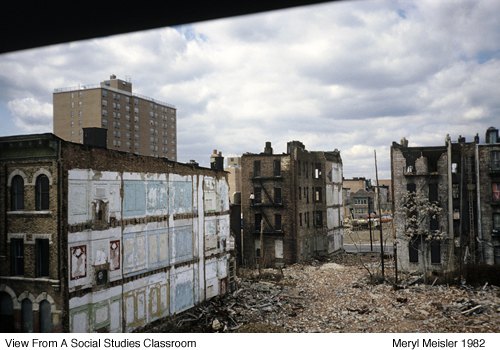Photos by Meryl Meisler, Text by Tobias Salinger

Photographer Meryl Meisler gleefully transported everyone back to the past at a tiny Dominican joint the other day. The fluorescent humanity of her 1984 homage to Edward Hopper (see above) merged with the subtle sweetness of fried plantains at Cibao Restaurant over by the Myrtle-Wyckoff station.
Meryl, 61, reminisced over lunch about how her job as an art teacher at Bushwick’s IS-291 helped her capture the arresting images of resilience amid rough circumstances for which she is known.
“Looking back, I’m very conscious of the fact that I was doing positive reinforcement,” she said. “I was photographing things I found uplifting.”
The picture she shot 28 years ago of Cibao (SEE-bow) Restaurant was first published in the Brooklyn Historical Society’s 2007 exhibition “Up From Flames,” which documented Bushwick’s recovery from the devastation of arson and blight. Meryl and others who witnessed the rise of Bushwick reference its improvement even as they caution that new developments threaten the neighborhood’s identity.
“There’s less money, but it’s better,” said Victor Rodriguez, the owner of Cibao Restaurant, about how the neighborhood’s changes have affected his restaurant. “You don’t get robbed as much. They used to shoot at you just to see you jump.”

Rodriguez, 42, has cut staff and spends most days fixing equipment at his restaurant while two of his sisters-in-law and his brother help customers.
Rodriguez has owned Cibao since 1996, and he said he plans to put up Meisler’s picture of his restaurant’s old location in the Myrtle-Wyckoff JMZ stop on the wall. He wore an amused expression as Meryl conducted her normal m.o. of photographing everyone in sight.
The curly-haired brunette lady with an aura of compassion snapped shots of the whole restaurant this time.


Meryl became connected to Bushwick during her 14 years teaching at Roland Hayes I.S. 291 and the now defunct Rosa T. Weatherless Alternative School. She said she was shocked at the condition of the neighborhood when she started teaching in Bushwick in 1981.
“It looked like the aftermath of a war zone,” she said. “It looked like a bombed out place.” The school’s campus overlooked the remains of houses destroyed in Bushwick’s “All Hands Fire” of 1977 and the accompanying blackout.

The scarred neighborhood became her passion before it was hip.
“I think Bushwick’s a very friendly, open, warm place,” Meryl said. “I feel very welcomed here.” She added that she often runs into former students.
The man sitting at the next table overheard us talking about how Bushwick used to be and took an interest, so Rodriguez showed John Moreira the picture.

They got to talking and realized that Meisler had been John’s art teacher in the early ‘80s. John Moreira, 44, the owner of the New Ridgewood Car Service next door, said Cibao Restaurant “makes me think of old times, when I was a kid.”
John started grabbing take out from Cibao on his way to and from the subway in the early ‘80s when the little place opened in its original location. He was 16 when the photo was taken, probably just a little bit younger than the young fellow in Meisler’s composition. Meryl commented that she hoped someone would recognize the guy from her picture the next time she visited.
Longtime residents like Moreira stop into Cibao for cheap traditional fare like rice and beans, mofongo (stuffed fried plantains in chicken broth) and mondongo (tripe soup). People know the food so well that they rarely check the menu.
The trip down memory lane led both Meryl and Moreira to the surreal elements of their school. Meryl and John laughed as they reminisced about the teacher who counseled Meryl to throw a chair across the room to intimidate the students, and another teacher who dressed in his Vietnam fatigues and boots on the first day of classes to let the restless youth know who was in command.
But Moreira said teachers like Meryl inspired a bond with the students instead of scaring them.
“The good teachers always had the good students who would respect them,” he said. “We were motivated, we would protect them.”

All the talk of Bushwick’s past led people at the restaurant to talk of the future. Moreira voiced concern that he never sees the families he grew up around in Bushwick.
“Up to two years ago, we used to go back to our old block,” Moreira said. “But now everyone’s gone because they’ve been pushed out.”
Bushwick is still 65 percent Latino and 8.5 percent white overall according to the latest numbers from the census, though the “white non-Hispanic” population grew by almost 6 percentage points between 2000 and 2010.
“In the long run, as long as affordable housing legislation honors and protects people who live here, I think an economically and ethnically diverse neighborhood is a healthy one,” Meryl had said to me at an earlier time. On this day at Cibao, she said it with her pictures. She left several prints of her Cibao picture at the restaurant and returned the following week for lunch.


